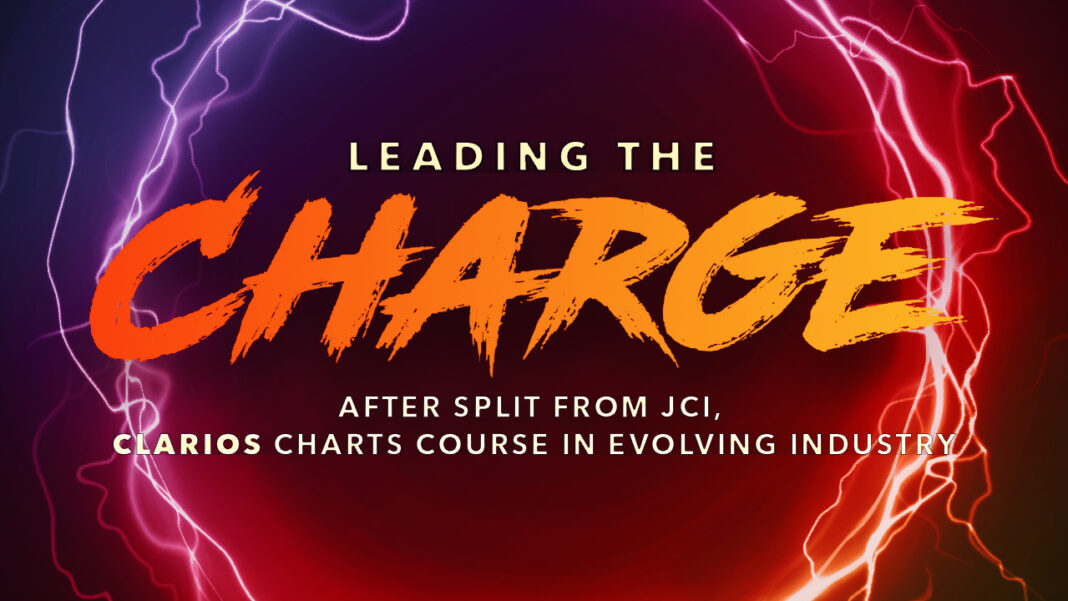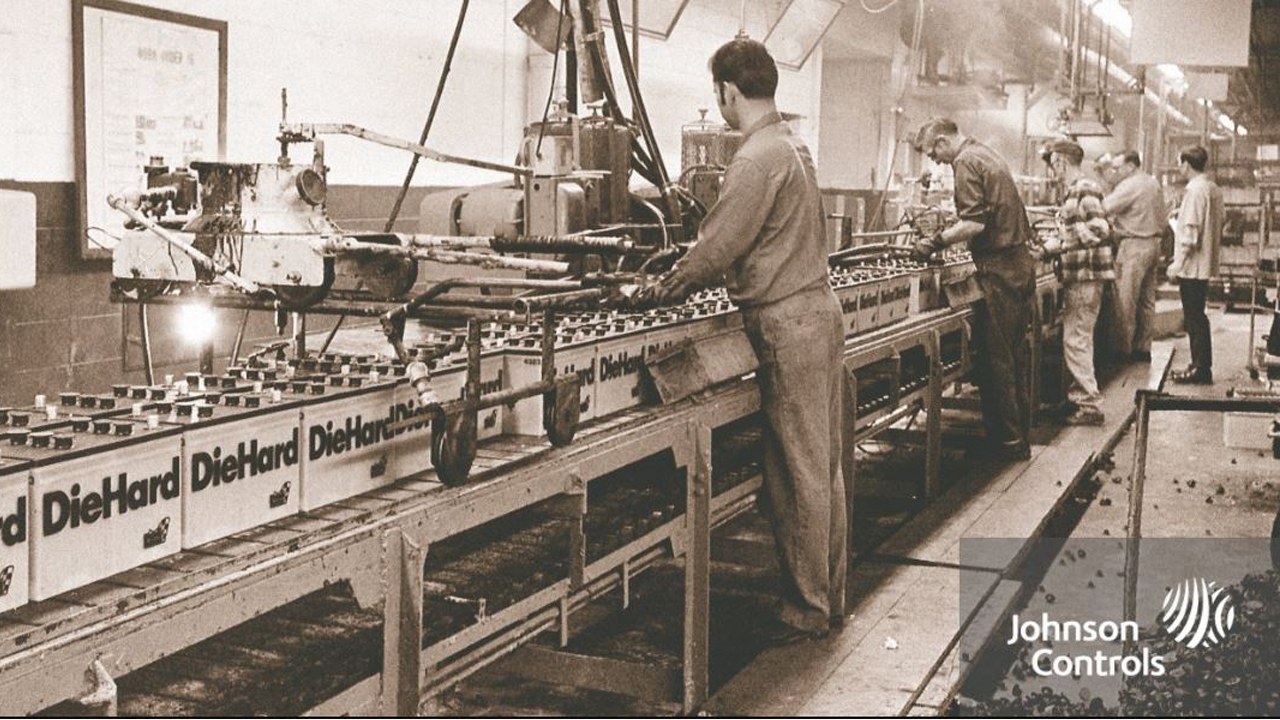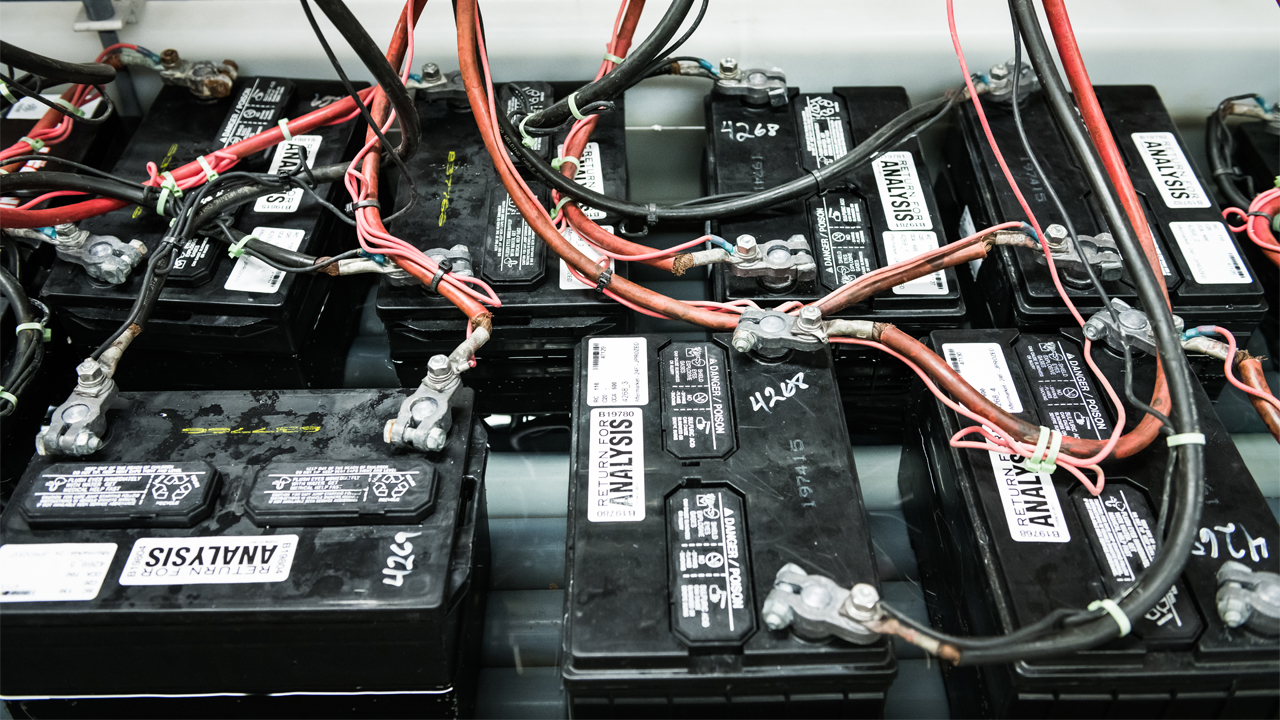Hundreds of car batteries are submerged in water on any given day inside the battery lab at Clarios, an automotive battery manufacturer based in Glendale.
While it might seem unusual, it’s a method used to measure a 12-volt battery’s capacity, electrical testing and its initial current capability. Some baths are set to room temperature while others are raised to as high as 70 degrees Celsius to simulate the conditions under the hood of a vehicle, said Jason Fuhr, Clarios engineering director.
“By raising the temperature, we’re able to accelerate the life of the battery and understand their performance,” Fuhr said. “Even still, you’re accelerating it but you’re talking about months to years.”
That’s because controlling and managing water temperature is a lot easier than air, allowing engineers and scientists to test the failure modes of batteries at a faster rate. Months to years is a considerably shorter timeframe when compared to the five- to seven-year life expectancy of a battery, Fuhr said.
Clarios, formerly known as Johnson Controls Power Solutions, is the world’s largest automotive battery manufacturer and also one the oldest in the U.S., with its lineage tracing back to Sears and Roebuck catalog issues of the early 1900s.
Since splitting from Johnson Controls International plc in May of 2019, Clarios has largely operated quietly from its Glendale campus. Now almost a year old, the company faces an evolving auto industry as it heads into the next decade under new leadership.
At the center of the company’s 277,700-square-foot headquarters is a large (69,000-square-foot) and expensive research battery lab where Clarios analyzes, develops and tests its products. Although the lab is one of 10 around the globe, it has several capabilities unique to the facility.
“We have the ability within this facility to analyze, develop and test all of our battery technologies – kind of leading the way towards new products in the market as well as the products our customers are asking for today,” Fuhr said.
Scientists in the lab can conduct organic analysis or chromatography, which is the study of gases produced by chemical reactions within a battery. The battery lab is equipped with a Scanning Electron Microscope, which enables scientists to image small particle structures.
Clarios also has a vehicle lab where engineers conduct benchmark testing of its batteries on the newest vehicle models to understand how and if products meet the needs of auto manufacturers.
However, one of the company’s most essential testing tools is its CT scanner, which provides a non-destructive way of getting an inside look to understand how a battery may have failed. Clarios uses a lot of injection molding parts, so the CT scanner can locate voids in components, which can improve their own manufacturing processes and that of their suppliers, Fuhr said.
“That has been really powerful with our customers because we may be able to go in and find something that historically our competitors would not be able to identify,” Fuhr said.
Clarios has a robust portfolio of battery technologies designed to power virtually every type of passenger, commercial and recreational vehicle, from conventional to fully electric. Its primary customers are global automakers, wholesale distributors, auto retailers and big box stores.
In May 2019, JCI completed its $13.2 billion sale of its power solutions business to Brookfield Business Partners, a Canadian private equity firm, and Caisse de dépôt et placement du Québec, an institutional investor that manages public pension plans in Quebec.
In fiscal 2018, then Power Solutions generated approximately $8 billion in annual revenue and produced about 150 million batteries each year. The company now has 16,000 employees across 50 manufacturing, distribution and recycling locations with 500 employees at its headquarters in Glendale.
The brand of the company was changed throughout the facility overnight to reflect the new name, which former Clarios president Joe Walicki said is “about the idea that our path going forward is clear,” he previously told reporters on a call following the sale.
Clarios’ headquarters remains on the same corporate campus as Johnson Controls and although new security measures have been added to separate the two businesses’ operations, they still share some services, including a gym, a cafeteria and nurses’ station.
Walicki was named president and CEO following the sale, however, he retired in December 2019 after more than three decades with Johnson Controls. Clarios is currently led by Brookfield Business Partners executive John Barkhouse, who is interim CEO and also the board chairman.
The company has yet to replace its CEO, but expects to name a new leader in the coming months, Clarios spokeswoman Kari Pfisterer said.
Leading up to the sale, public equity investors had a difficult time valuing JCI’s Power Solutions business, said Timothy Wojs, Baird general industrial senior research analyst.
“On the one hand, you had a largely replacement-oriented legacy business around lead-acid batteries, where Power Solutions had a market leading position and that provided a fairly nice recurring revenue business,” Wojs said.
On the other hand, the ongoing transition toward hybrid and electric vehicles, which would require significant investments in new technology, could pose a threat to the legacy business over a longer period of time.
JCI pursued a strategic alternative for the business, ultimately selling it to BBP to focus on its core buildings business, Wojs said.
“It’s fairly consistent with what we’re seeing in the industrial world overall,” Wojs said. “This theme of deconglomeratization, where the sum of a company’s parts winds up being more valuable than the combined company, so it makes sense to split them apart.”
Although BBP manages a relatively diverse array of businesses, it is primarily focused on industrial and business service companies. Through this lens, the acquisition is aligned with the firm’s investment mandate, said Devin Dodge, BMO Capital Markets equity research analyst.
“What makes Clarios a bit unique versus its other investments was the size of the investment and (it) highlights the scale advantage of BBP relative to many other private equity firms,” Dodge said.
Dodge believes a number of factors led BBP to acquire Power Solutions, including its leading global market position, high barriers to entry and steady demand profile given that most if its sales are from the aftermarket.
However, under Johnson Control’s ownership, Power Solutions had fallen short of management’s targeted margin and profitability improvement, Dodge said.
“We suspect that the battery business may not have received the capital and management attention that it required, particularly in U.S. operations,” Dodge said.
Craig Rigby, vice president of technology at Clarios, described the transaction as atypical in terms of private equity acquisitions.
“Based on the results, Clarios was already a strong company,” Rigby said. “This wasn’t a turnaround situation in the sense that a lot of private equity things can be.”
Rigby said the transition has been positive, adding that BBP has given Clarios the freedom to consider how to add value to the company and how it should be run.
“They challenge us in many ways in which we weren’t being challenged before,” Rigby said. “Not only in our execution, but also in the way we think about the nature of the business and stretching into areas that maybe we wouldn’t have before.”
Johnson Controls’ Power Solutions business was born from JCI’s acquisition of Milwaukee-based Globe-Union Manufacturing Company, which long held the title as the largest automotive battery manufacturer in the world before becoming a JCI subsidiary.
Globe’s original business, which dated back to 1911, was manufacturing lighting equipment for farm, street and railway use. As the lighting equipment business dwindled in the early 1920s, the company switched gears to the production of automobile batteries, according to Johnson Controls’ website.
Globe was convinced the future was in automobiles, so the company negotiated a contract with Sears to provide batteries for its catalog business in 1924. A year later, Globe needed to meet the demand for batteries, so a company executive formed the Union Battery Company of Chicago.
The operations of Globe Electric and Union Battery were consolidated in 1929 to form Globe-Union Manufacturing Company.
In 1978, Johnson Controls acquired Globe-Union, Inc., becoming a leading domestic manufacturer of automotive batteries for the United States replacement market and the combined domestic replacement and original equipment market.
Around 2008, then JCI Power Solutions responded to a change in the automotive industry, in which certain parts of the world, such as Europe, saw tighter environmental regulations. Auto manufacturers were required to reduce emissions and improve fuel efficiency, and began implementing new technologies to meet their needs, such as “start-stop,” a feature that temporarily turns off a vehicle at a red light rather than sitting idle.
While certain types of lead-acid batteries can power a vehicle with start-stop capabilities, others are not equipped to do so over a long period of time. The composition of traditional lead-acid batteries is such that to charge and recharge the battery frequently (turning a car on and off) would considerably reduce the battery’s lifespan, Rigby said.
As auto manufacturers increase the complexity of vehicles, adding both computer technology and new features, Clarios has to follow suit, innovating its products to meet vehicle electrification and stringent fuel economy requirements.
“That has really forced us to develop a broader range of products that have evolved from the traditional starter battery to things like Absorbent Glass Mat or enhanced battery technology, which improve the capability to support things like start-stop,” Rigby said.
It may seem counterintuitive to place so much emphasis on lead-acid battery technology as opposed to, for example, lithium ion technology, which is used as the primary source of power in electric vehicles. But Rigby says vehicle electrification is not happening as fast as it may appear, adding that large format lithium ion batteries have their challenges.
“The challenge on the larger format batteries, to be blunt, it’s a slowly evolving market despite all of the hype and all the articles about how everything’s changing,” Rigby said. “It is changing, but it’s changing much slower than what people think.”
In 2019, a total of 17 million vehicles were sold in the U.S., compared to approximately 1.5 million EVs on the road total, according to the Edison Electric Institute, an association representing all U.S. investor-owned electric companies.
However, EVs are expected to grow in popularity over the next decade. By 2030, the number of EVs on U.S. roads will reach more than 18 million – or 7% of the 259 million vehicles (cars and light trucks) expected to be on U.S. roads in 2030, according to the EEI.
Still, Clarios is not betting all of its chips on the apparent shift to EVs. Instead, the company is doubling down on the growing demand for two emerging technologies in lead-acid. The first is Absorbent Glass Mat (AGM), which can support start-stop technology, and the second is enhanced flooded battery, which is built for an extended life and with a larger number of charging cycles.
“The reality is that 90% of the vehicles produced every year are still relying on engines and traditional battery or AGM battery technology to enable their power needs,” Rigby said.
A primary reason for the continued high demand for lead-acid products is that almost all EVs, whether Tesla, Ford, GM or BMW, have a large format lithium ion battery coupled with a 12-volt lead-acid battery and in many cases, an AGM battery produced by Clarios, Rigby said.
When a person walks back to their car, hits the remote and the car “wakes up,” the high voltage lithium ion battery of an EV still isn’t on; all that power is coming from a 12-volt battery. In EVs, it’s the 12-volt battery’s responsibility to both jump-start the high-voltage battery to run the vehicle and at the same time, serve as its backup in case of malfunction.
“Even though one’s very big and, frankly, expensive and one’s much smaller, there’s a symbiotic relationship between what the 12-volt battery does to enable the high voltage battery,” Rigby said.
A lot of weight is placed on the reliability of lead-acid products and as vehicle manufacturers see advancements in technology, like autonomous vehicles, their role only becomes more significant. In the case of autonomous vehicles, it’s critical to ensure there is sufficient power. If there’s a malfunction, you can no longer count on the driver to bring the vehicle to the side of the road, he said.
“We don’t worry about the shift to EVs, to be honest with you, because we’re still going to sell our core products into those applications,” Rigby said. “It’s really about managing that transition with our customers in terms of how their needs evolve.”
At the same time, Clarios is exploring another segment of the low-voltage electrification space through a partnership with Toshiba. Together, the companies produce a dual-volt battery solution by pairing an AGM battery with a 12-volt lithium ion battery. The lithium ion part of the system powers vehicle functions, but doesn’t start the vehicle.
Despite its partnership with Toshiba, Clarios believes its lead-acid products can reach the same efficiency levels without the help of lithium ion technology, Rigby said.
“Even though it’s a small lithium battery, it’s not inexpensive; it’s still a challenging technology from a price perspective and a consumer perspective,” Rigby said. “If we can get 80% to 90% of that benefit with an improved lead-acid battery, that’s a much better value proposition to automakers and ultimately to consumers.”
Although Rigby doesn’t see the automotive battery industry through the lens of “lithium ion versus lead-acid,” Clarios prides itself on the closed-loop circular economy of lead-acid battery products in the U.S. In fact, 99% of lead-acid batteries in the U.S. are recovered and recycled, according to the Responsible Battery Coalition, a group focused on implementing sustainability metrics and tools for battery life-cycle management.
“When someone buys a new battery, that old battery goes into the system and is recovered, it’s processed through recycling and then 97% of the material in that battery is repurposed,” Rigby said.
The lead is used to make more automotive batteries, the plastic is used to make new battery cases and the sodium sulfate is sold as a commodity and used in a variety of other industries such as glass manufacturing, detergent manufacturing and paper pulping.
Clarios is a founding member of the RBC, which was established in 2017. As an automotive battery manufacturer, the company has adopted a philosophy to critically think about what it means to manage both its materials and products through their entire life cycle, Rigby said.
“As new technologies come to market, be it lithium ion, lead-acid or any new battery technologies, we should have the philosophy that if you can do it with lead-acid, you can do it anywhere,” Rigby said. “No battery should avoid being responsibly managed through its life cycle to the greatest extent possible.” n












